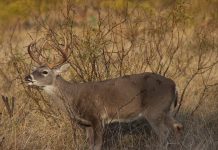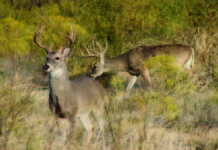Chronic wasting disease has become a hot-button issue in the Texas white-tailed deer-hunting landscape, and the most recent positive test from a captive deer shot on a release site is only going to heat up the debate.
The Texas Parks & Wildlife Department and Texas Animal Health Commission are said to be conducting an epidemiological investigation, according to a news release submitted in February about the January harvest of the 3 1/2-year-old captive raised white-tailed buck from a ranch in Medina and Uvalde counties. The deer’s origin was identified as an onsite deer breeding facility, according to the release.
Tissue samples revealed the presence of CWD prions during testing at the Texas A&M Veterinary Medical Diagnostic Laboratory in College Station. The samples were submitted to the National Veterinary Services Laboratory in Ames, Iowa, which validated the suspect findings, according to the release.
The disease was first recognized in 1967 in captive mule deer in Colorado. CWD has also been documented in captive and free-ranging deer in 23 states and two Canadian provinces. The disease in Texas was first discovered in 2012 in free-ranging mule deer along a remote area of the Hueco Mountains near the New Mexico border, and last summer was detected in two captive white-tailed deer breeding facilities in Medina and Lavaca counties.
CWD among cervids is a progressive, fatal disease that commonly results in altered behavior as a result of microscopic changes made to the brain of affected animals. An animal may carry the disease for years without outward indication, but in the latter stages, signs may include listlessness, lowering of the head, weight loss, repetitive walking in set patterns, and a lack of responsiveness. To date there is no evidence that CWD poses a risk to humans or non-cervids. However, as a precaution, the U.S. Centers for Disease Control and Prevention and the World Health Organization recommend not to consume meat from infected animals.






















